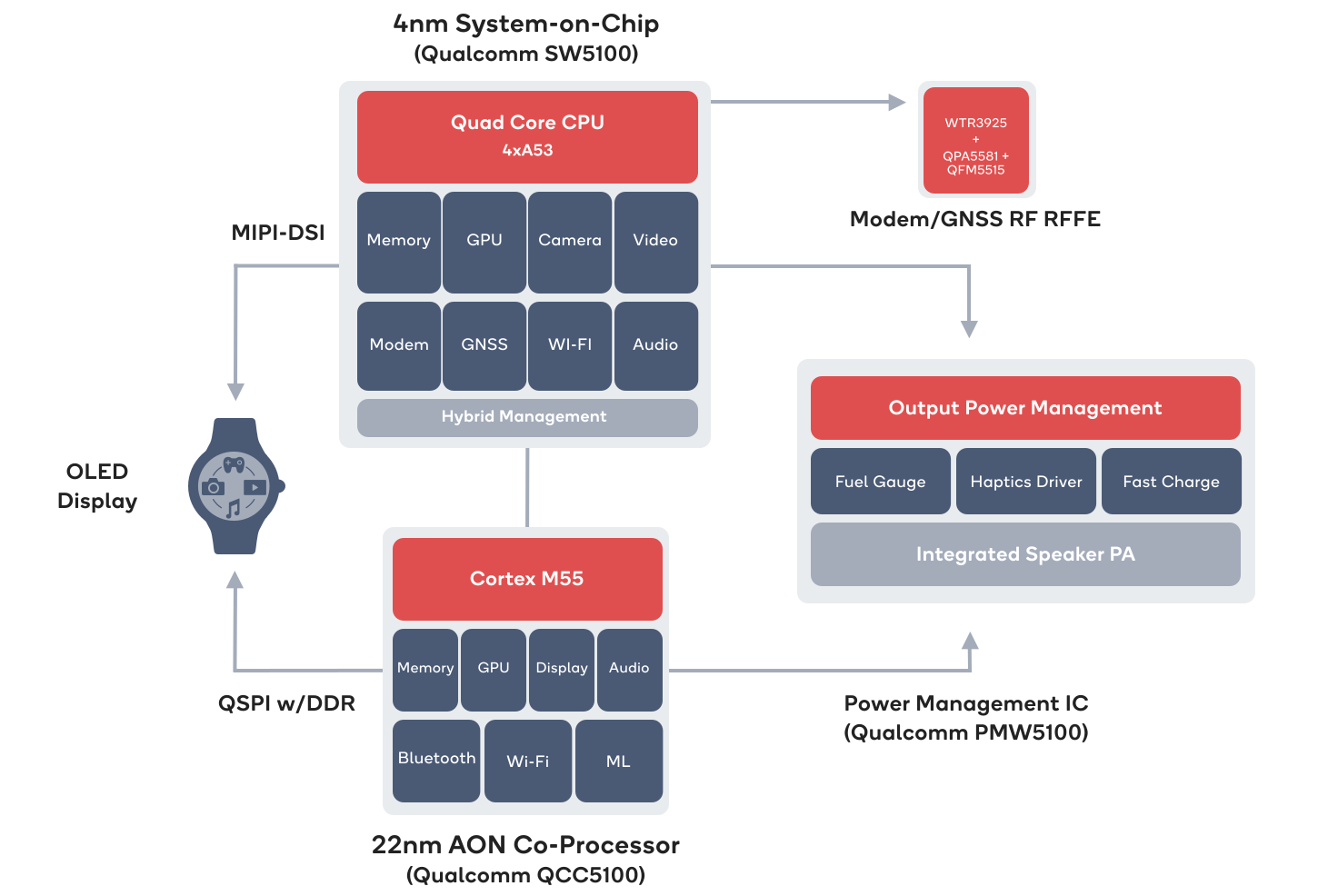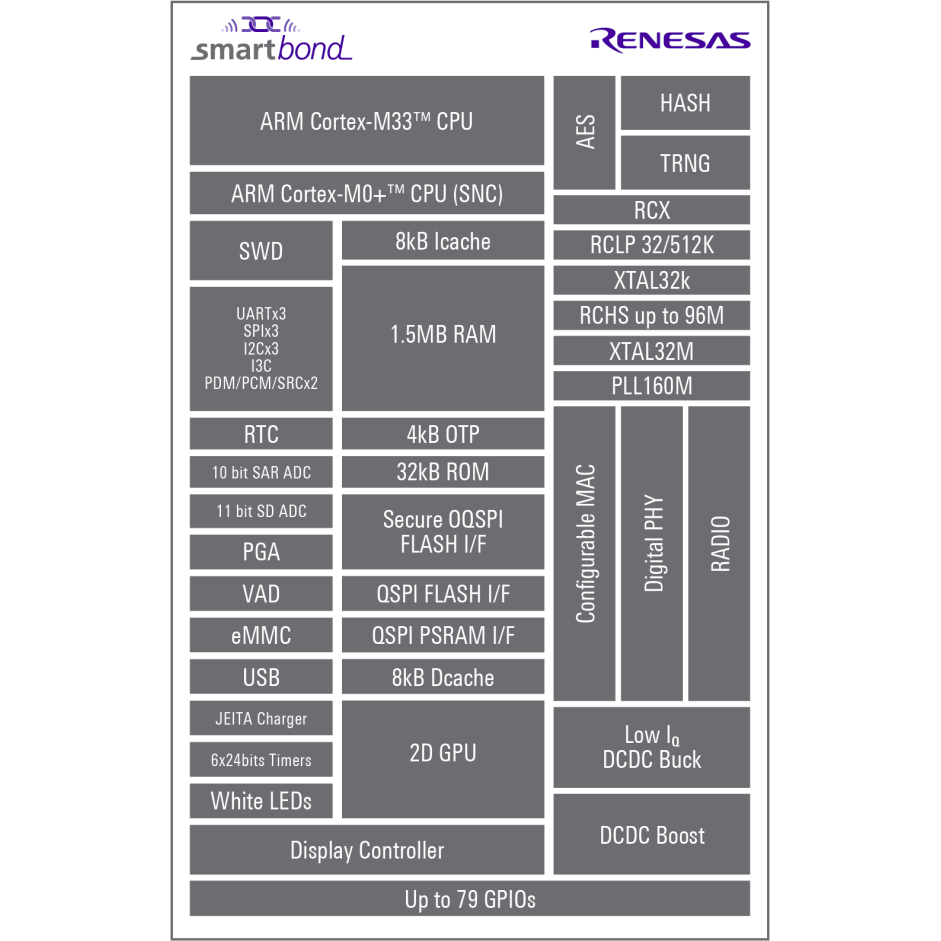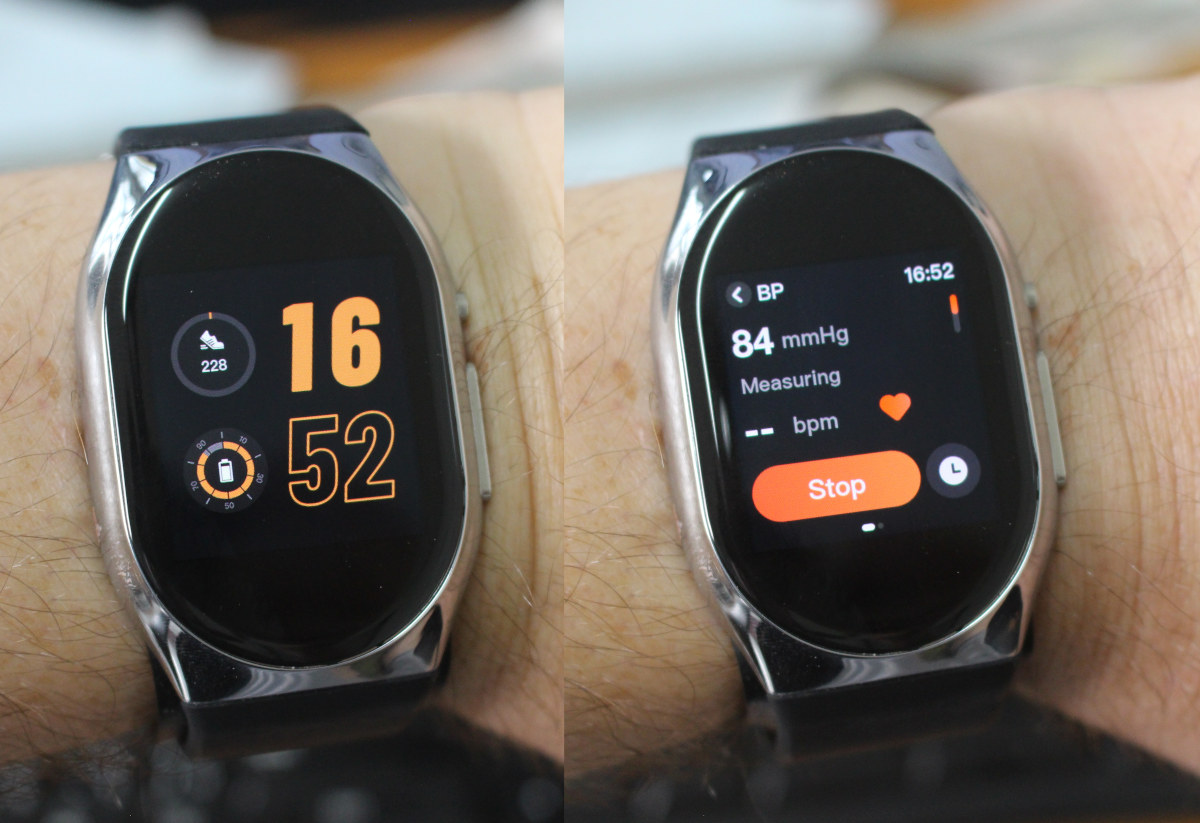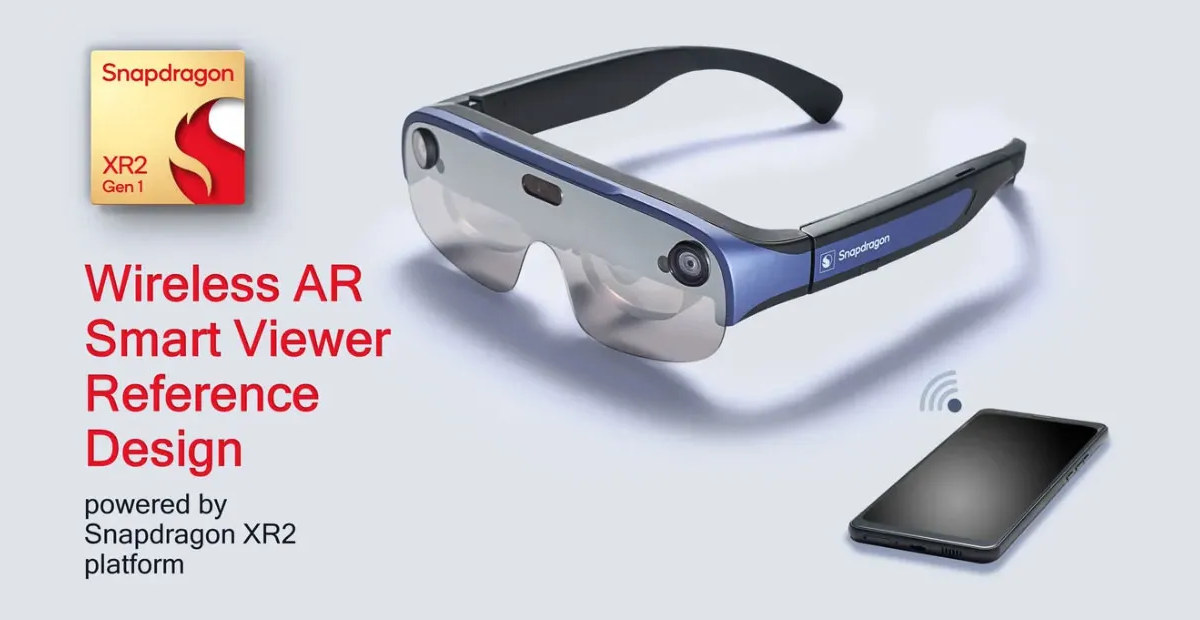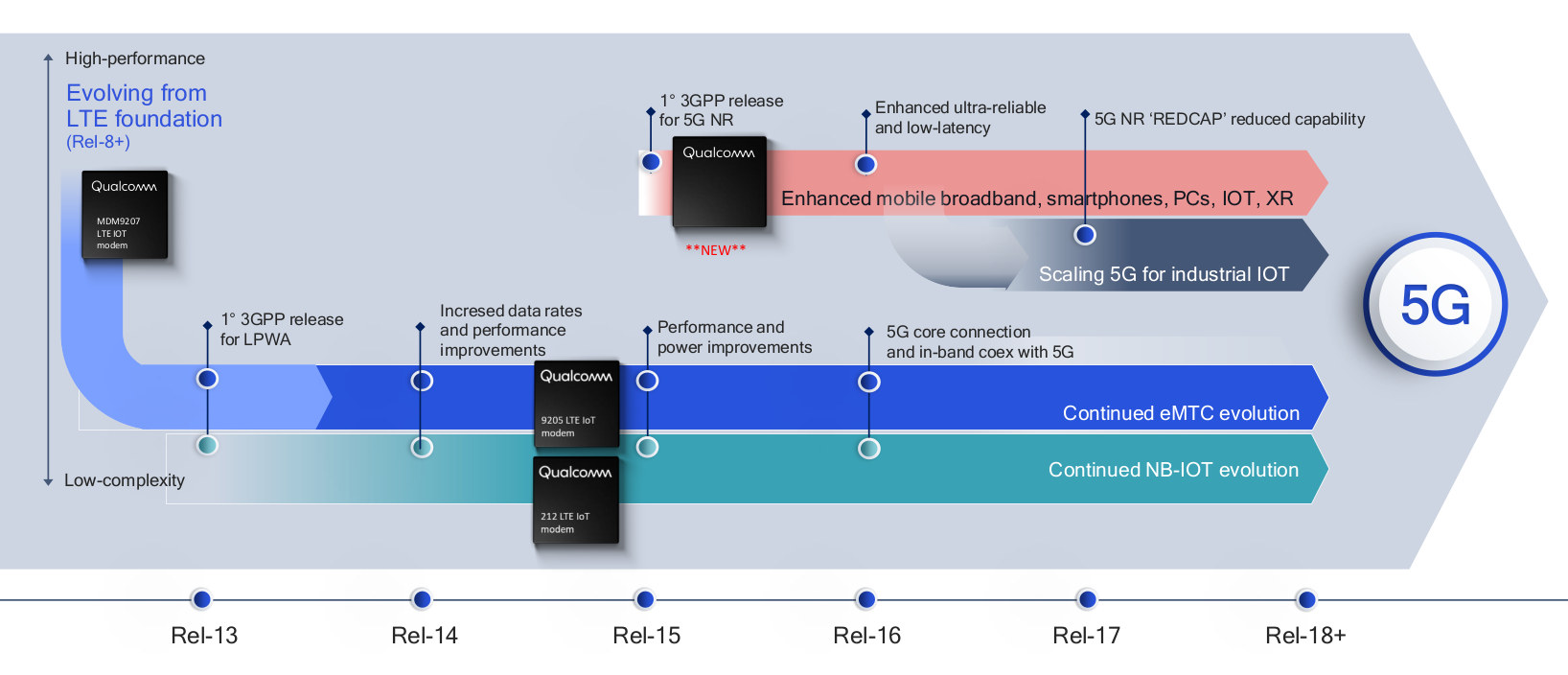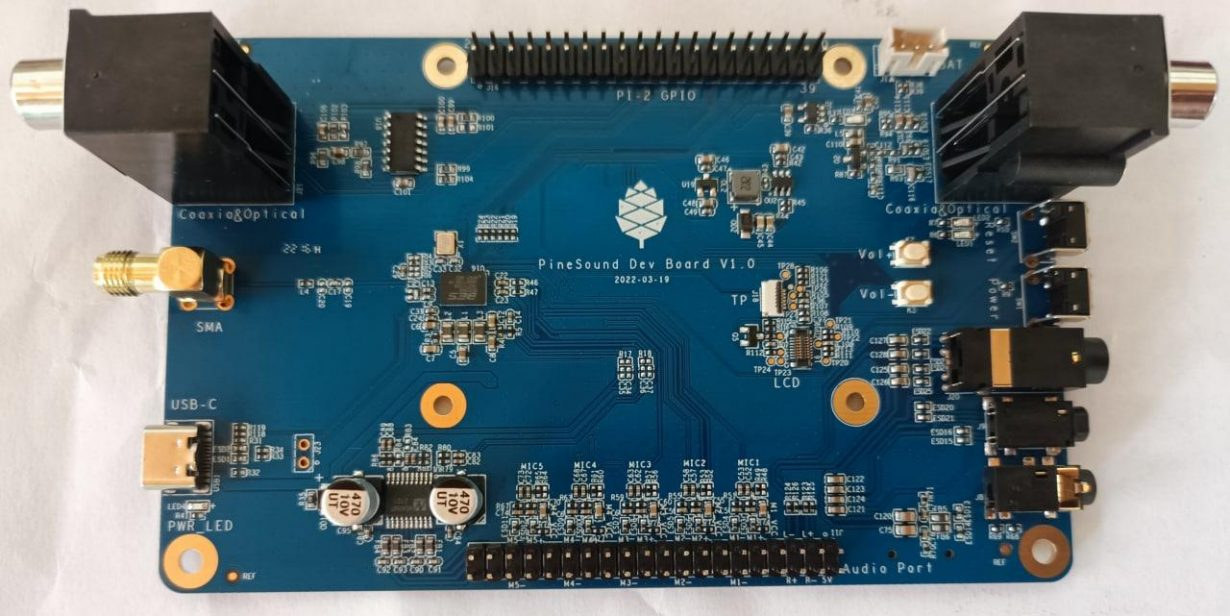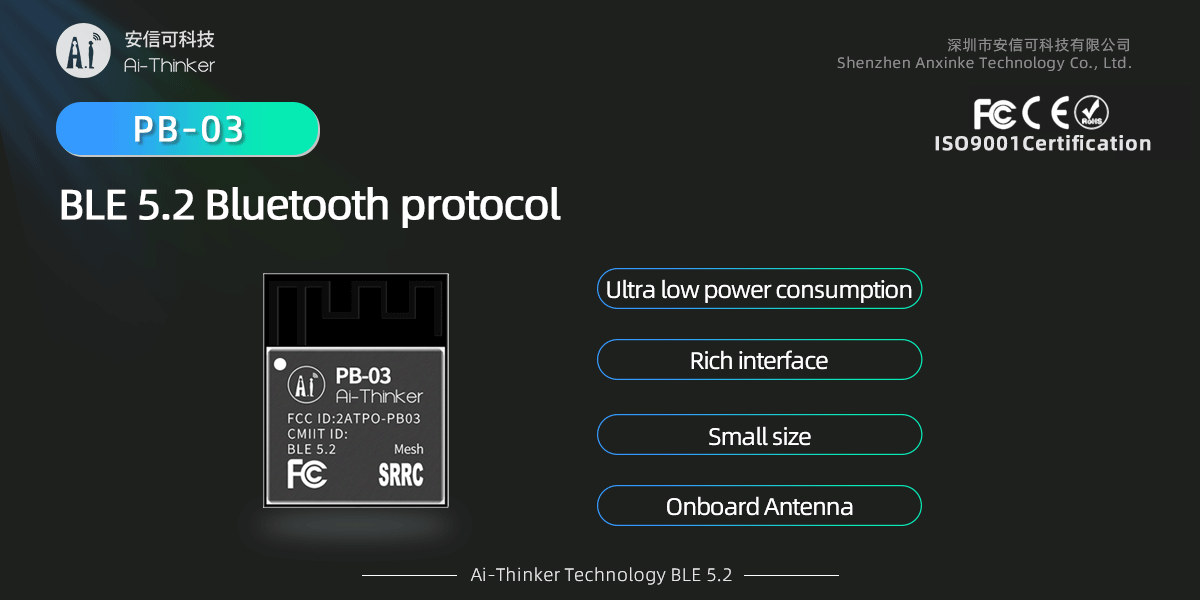It’s been a while since Qualcomm released a new platform for wearables. More exactly, the Snapdragon 4100 platform was announced a little over two years ago, and now Qualcomm has just introduced the Snapdragon W5+ and W5 Gen 1 platforms with up to 50% longer battery, twice the performance, and 30 percent smaller size. Just like the Snapdragon 4100, the Snapdragon W5 comes with four Arm Cortex-A53 processor (SW5100), but is clocked at 1.7 GHz and manufactured with a 4nm process, while the always-on (AON) co-processor is upgraded from a Cortex-M0 chip to the QCC5100 Cortex-M55 chip manufactured with a 22nm process. Snapdragon W5+/W5 specifications: W5100 SoC CPU – Quad-core Cortex-A53 processor @ up to 1.7 GHz GPU – Qualcomm Adreno A702 @ up to 1 GHz with OpenGL ES 3.1 API support DSP – Qualcomm Hexagon DSP V66K System Memory – 16-bit LPDDR4 up to 2,133 MHz […]
Renesas SmartBond DA1470x Bluetooth 5.2 LE SoC features a 2D GPU
I would not usually ask myself “is there a GPU?” in a Bluetooth LE SoC, but that’s exactly what Renesas SmartBond DA1470x Bluetooth 5.2 LE microcontroller offers with a 2D GPU used to accelerate the rendering of user interfaces in wearables, healthcare devices, home appliances with displays, industrial automation and security systems, as well as consoles in e-bikes and gaming equipment. The DA1470x also comes with a Cortex-M33 application core, a Cortex-M0+ sensor node controller, 1.5MB SRAM, and an ultra-low-power hardware VAD for always-on audio processing, as well as various peripherals. Specifications: CPU cores Arm Cortex-M33 core @ up to 160 MHz for the application Arm Cortex-M0+ core acting as a sensor node controller (SNC) GPU – 2D GPU for advanced graphics processing Memory – 1.5MB SRAM Storage 4 kB OTG, 32KB ROM on-chip Decrypt-on-the-fly Octa/Quad SPI flash interface Dedicated QSPI PSRAM and QSPI flash interfaces eMMC interface supporting up […]
Think Silicon NEOX RISC-V GPU offers 3D graphics or AI acceleration
Think Silicon NEOX GPU family with models optimized for graphics (NEOX|G) or artificial intelligence (NEOX|A) is based on the RISC-V RV64C ISA instruction set with adaptive NoC, and offers up to 64 cores delivering up to 409.6 GFLOPS at 800MHz with support for FP16, FP32 and optionally FP64 and SIMD instructions. The NEOX GPUs can be integrated into microcontrollers, crossover processors, and even more powerful application processors, and target AI, IoT/Edge, and media processing in consumer and industrial devices. Each shader of the GPU is a programmable 64-bit RISC-V (RV64GC) core running a real-time operating system (RTOS) and the GPU is supported by lightweight graphics and machine learning frameworks. The multi-threaded GPU system can be customized for graphics, machine learning, vision/video processing, and general-purpose compute (GPGPU) workloads. The solution is meant to be integrated into 32-bit SoCs designed for smartwatches, augmented reality (AR) eyewear, video surveillance, and smart display terminals […]
BP Doctor PRO review – A 2-in-1 smartwatch and blood pressure monitor
So far, If I wanted to monitor my blood pressure monitor and overall fitness, I’d use a Bluetooth blood pressure monitor (Koogeek BP2) plus a fitness tracker/smartwatch such as Weloop Key S3. It does the job, but WearWiz has come up with something much more compact with the BP Doctor Pro 2-in-1 device that acts as both a smartwatch/fitness tracker and a blood pressure monitor, and at $299, offers a cheaper alternative to the $500 FDA-approved Omron Heartguide. The company sent a sample to CNX Software for review, so we’ll have a look at the device and accessories, the Android app, and features such as blood pressure monitoring, HRM, SpO2 level monitoring, and more. The review is rather long, so if you are short on time, you may want to check the two sections: Blood pressure monitoring with BP Doctor PRO smartwatch Conclusion with Pros and Cons BP Doctor PRO […]
Lightweight wireless AR Smart Viewer reference design is powered by Snapdragon XR2 platform
Qualcomm unveiled a new Wireless AR Smart Viewer Reference Design powered by the Snapdragon XR2 platform last week with very few details, but the company has now demonstrated the system to some members of the press, so let’s have a closer look. The reference design aims to provide a similar level of performance as a headset connected to PC or premium smartphone, but with some of the processing offloaded to the Snapdragon XR2 processor, thereby eliminating the need for a cord while still achieving lag-free experiences in combination with the Qualcomm FastConnect 6900 WiFi 6 and Bluetooth 5.3 solution. It is supposed to offer a 40% thinner profile and a more balanced weight distribution than the earlier Snapdragon XR1 smart glasses reference design. Wireless AR Smart Viewer reference design specifications: SoC – Qualcomm Snapdragon XR2 with Octa-core processor with 1x Kryo Gold prime @ 2.84 GHz + 3x Kryo […]
5G RedCap leverages 5G features, limits bandwidth to 85Mbps for industrial IoT applications
5G is often associated with Gigabit speeds when found in mobile handsets or connected laptops, while there’s also 5G LPWA for battery-powered IoT devices. 5G RedCap, which stands for Reduced Capability, offers a middle ground for industrial IoT applications that keep some 5G features such as low latency, low power consumption, enhanced security, and network slicing while limiting the bandwidth to around 85 Mbps. 5G RedCap, also called NR Lite, will be part of 3GPP Release 17 scheduled for later in 2022, and further improved in Rel 18 in 2023. It will be first found in applications currently relying on LTE Cat 1 through Cat 4, and can be considered a light version of the 5G standard. An article on Telit says Rel 18 will specifically address the low-power wide-area network (LPWAN) segment currently carried seamlessly (e.g. no hardware changes required) in 5G by LTE-M and NB-IoT. I found out […]
PineSound is a development board for earbuds and digital audio players
You may have read Pine64’s April’s Fools spoof about the PineBuds and PinePod earlier this month. It turns out those will be real, and the Pine64 PineSound development board will be used to bring the PineBuds earbuds and PinePod digital audio player to market. The PineSound board features Bestechnic BES2300 Bluetooth 5.0 audio chip, two coaxial & optical input and output, a 3.5mm headphone jack, 4.4mm and 2.5mm balanced jacks, an SMA connector, a USB Type-C connector, plus interfaces for a touchscreen display. PineSound preliminary specifications: WiSoC – Bestechnic BES2300-YP dual-core Arm Cortex-M4F @ up to 300 MHz with HW DSP instruction, 992KB SRAM, 4MB flash, Bluetooth 5.0 dual mode. Supports hybrid ANC (active noise cancellation) and TWS (true wireless stereo). Note: the datasheet has been made available in the comments section. Display – LCD (should be SPI) and touch panel connectors Audio Coaxial & optical input (left) Coaxial & […]
PB-03 – A Bluetooth LE 5.2 module for the Smart Home, wearables, IoT, etc… (Sponsored)
What changes does Bluetooth LE 5.2 (BLE 5.2) bring? Maybe PB-03 module can tell you. PB-03 is a BLE module developed by Shenzhen Ai-Thinker Technology based on PHY+ PHY6252 32-bit microcontroller (see PDF datasheet) that offers high integration and low power consumption down to 0.3uA in OFF mode, and is well suited to various applications such as IoT, mobile devices, wearable electronic devices, and smart homes. PB-03 module’s highlights Ai-Thinker PB-03 provides an upgrade to earlier PB-01/02 modules with the following highlights: MCU – PHY6252 microcontroller with 256KB flash, 64KB SRAM Supports BLE 5.2 and Bluetooth Mesh Equipped with an on-board PCB antenna Up to 2 Mbps data rate I/Os – UART, PWM, ADC, I2C, SPI, PDM, DMA, and up to 19 IOs. Security – AES-128 encryption hardware Power consumption (PHY6252) 0.3uA @ OFF Mode (IO wake up only) 1uA @ Sleep Mode with 32KHz RTC 3.5uA @ Sleep Mode […]


